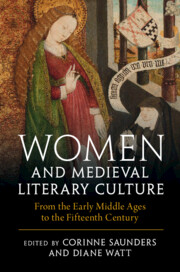Book contents
- Women and Medieval Literary Culture
- Women and Medieval Literary Culture
- Copyright page
- Contents
- Illustrations
- Contributors
- Acknowledgements
- Introduction
- I Patrons, Owners, Writers, and Readers in England and Europe
- II Circles and Communities in England
- III Health, Conduct, and Knowledge
- IV Genre and Gender
- V Women as Authors
- Chapter 18 Marie de France
- Chapter 19 Julian of Norwich
- Chapter 20 The Communities of The Book of Margery Kempe
- Chapter 21 Christine de Pizan
- Chapter 22 Beyond Borders
- General Index
- Index of Manuscripts
- References
Chapter 19 - Julian of Norwich
A Woman’s Vision, Book, and Readers
from V - Women as Authors
Published online by Cambridge University Press: 28 July 2023
- Women and Medieval Literary Culture
- Women and Medieval Literary Culture
- Copyright page
- Contents
- Illustrations
- Contributors
- Acknowledgements
- Introduction
- I Patrons, Owners, Writers, and Readers in England and Europe
- II Circles and Communities in England
- III Health, Conduct, and Knowledge
- IV Genre and Gender
- V Women as Authors
- Chapter 18 Marie de France
- Chapter 19 Julian of Norwich
- Chapter 20 The Communities of The Book of Margery Kempe
- Chapter 21 Christine de Pizan
- Chapter 22 Beyond Borders
- General Index
- Index of Manuscripts
- References
Summary
This essay explores the insights into female authorship offered by Julian of Norwichߣs Revelations of Divine Love. While we know very little of this figure, external evidence clearly identifies her as an anchoress celebrated for her holiness and spiritual guidance, and she is the first woman writer to use English who can be identified. Windeatt explores the distinctive witnesses to medieval womenߣs literary culture offered by the two extant texts of the Revelations. The shorter version, almost certainly earlier, is explicit about its female authorship, but reflects no particularly female approach. The longer version, by contrast, suppresses reference to female authorship but develops a uniquely woman-centred exposition of deep theological sophistication that suggests extensive learning. The afterlife of Julianߣs Revelations sustains the process of editing, as the short text finds its way into an anthology while excerpts of the Long Text are woven into a florilegium probably for nuns, whilst post-medieval communities of nuns ensure the survival of Julianߣs book.
Keywords
- Type
- Chapter
- Information
- Women and Medieval Literary CultureFrom the Early Middle Ages to the Fifteenth Century, pp. 400 - 419Publisher: Cambridge University PressPrint publication year: 2023

